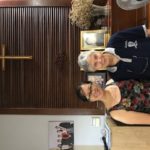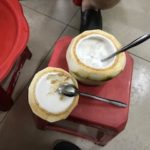by Betsy Robson | Sep 16, 2018 | Vietnam
Remember, you may click on a photo to enlarge it. The drummer and cymbal player, the  head, attaching the skirt, the final product.
head, attaching the skirt, the final product.
15 September
Every night now for several weeks there has been a lot of drumming in the park across from the hotel, usually beginning around 2000 and lasting at least an hour, sometimes twice that long. I finally decided to check it out and found I had happened on practice for a two-man dragon, in full regalia. I surmised this might be preparation for some sort of celebration and asked at the school if such were in the offing. I learned that on 24 September there will be country-wide full moon celebrations. (I have not once seen the moon in my seven weeks here.) Moon pies are de rigeur and there are parades and lots of noise. Eight nice looking, tall slim Vietnamese boys made up the practice, with two wearing dragon leggings. I watched as they attached the skirt to the head and then took a couple of videos of the rhythmic dance. A lot of athleticism in the lifts from what appeared to be boys not strong enough to hold a partner high above their heads. Now I hope I can find where one of the parades will be held so I might enjoy the whole show. Unfortunately, it was too dark to see well many of the pictures and videos I took. the drummer
the drummer
 the head
the head 
by Betsy Robson | Sep 16, 2018 | Vietnam
14 September



Betsy and Rebecca at the Vu’s apartment, those very low stools on which nearly everyone sits at outdoor restaurants, the coconut jelly, top on left, bowl on right.
After school, Principal Rrbecca Pham and Pastor Jacob Vu invited me and teacher Lheonie to dinner at their apartment. It had been raining hard all afternoon. Lheonie and I were about to call a can when Rebecca called. It had just stopped raining, and at first Lheonie and I were preparing to walk, but Rebecca said Jacob was on his way to pick us up in the car. They live on the 37th floor of a large complex in a beautiful three bedroom two bath apartment. I got dizzy as Jacob drove round and round down several levels in the parking garage.
Rebecca had cooked prawns ala Vietnam (with legs, feelers, shells and guts, a beautiful beef and mushroom plate, cucumber salad with a delicious dressing, and honied lemonade. After dinner we sat for a while over tea in their living room. Jacob told me that before his call to ministry he had worked as an electrical engineer, and he proudly told me he had designed the apartment’s interior with beautiful cabinetry and built-in shelves.
Then we went to the car and took a tour up the coast of the Westlake, back past the Ho Chi Minh memorial and into the French Quarter. We stopped at a small restaurant whose only food was coconut jelly, a dish I had neither seen nor heard of. A coconut’s fibrous exterior is remived, leaving only the hard shell; this is topped, leaving a small saucer-like dish, the interior is reamed down to about a sixth of an inch of meat and the rest of the meat is cut into small pieces, to which is added some sort of gelatin-like liquid. (We sat on those nine-inch high stools so ubiquitous here, and I knew I would never be able to stand up from mine. In the end it took all three of my companions to get me back on my feet.) This dish is served with flimsy long-handled spoons and all but I were able to clean the dish and the bowl of all the coconut meat.
Hanoi nighttime activity looks just like any other big city, with neon lights, noise and bustling traffic, but it was an enjoyable evening, and I know I shall not forget the coconut jelly. I wonder if I could find it at the Eden Center in Falls Church?
by Betsy Robson | Sep 11, 2018 | Vietnam
This is the second part of my trip to Cambodia1 – 3 September. It is not related to my mission trip to Vietnam but rather is a side trip I took over the three-day Vietnam National Day weekend. I have been unable to size photos to fit but will try to add them later.
CAMBODIA PART II
3 September – After a beautiful sunny day on 2 September, visiting the temple complex at Angkor Wat, this day was to include a boat ride to a floating village and participation in two local villages’ cottage industries. It began raining overnight and continued into the morning, the day we were supposed to be out and about. Rain, rain go away. I beat the Chinese to the breakfast room and commandeered a small table by a window. Then I repacked my bag for departure and met Johnny in the lobby at 0800. I had tried, at Johnny’s suggestion, to reconfirm my return flight to Hanoi, but could not get past the log-in page for the hotel’s WiFi.
By the time Johnny arrived the rain had stopped. I gave him a $10 tip, with $5 for the driver, and asked Johnny if he would give me the smallest Cambodian bill he had. He gave me a 100 Rial bill, at 4,000 to the dollar it is worth about ten cents. En route to the boat for the trip to the floating village, we crossed the Siem Reap river where, in November, there are dragon boat races, thirty people per boat paddling 600 meters. The winner goes to the finals later in Phnom Penh. These festivals celebrate the harvest. We passed a new market building that will soon open which will include a Starbucks. There are already KFC and McDonalds outlets in town, and one Starbucks at the airport. The outdoor market was bustling. Johnny said electricity is expensive so most homes do not have refrigerators, and many women go to market twice a day for the freshest produce. Few women work outside the home.
We followed the main road road south before turning into a rough dirt track, now thoroughly muddy from the ivernight rain, leading to the dock. We passed through a couple of villages with large and small houses on stilts, for protection from flooding, insects, snakes and looters. The latter sometimes come at night to steal chickens and motorbikes.
Johnny’s family lives 35 kilometers south and are rice farmers. When the family gets together there are the ten brothers and sisters and 21 nieces and nephews. His father is not well, and to help support the family Johnny sold his own home for the money to help. He, is divorced,mbut he and his former wife have four children (girls aged 17, 14 and 6 and a 16 year old boy). He lives in a small apartment in town. The family home has a concrete, lockable room where it can safeguard things from thieves. He is an independent travel guide and works only occasionally for Buffalo Travel. With no steady employer he has no steady income.
On the dirt road leading to the dock, we passed two busy villages. Everywhere in the country are roadside businesses under large umbrellas, selling everything from local produce to second-hand clothes to kitchy souvenirs. The area of these villages reminded me of what mother used to call such squalor: the underpants of the city. The road eventually debauched onto a long dirt (muddy) causeway lined with boats to take tourists to the near-by floating village – a misnomer, because the homes there do not float but stand above the water on stilts. That is, those do that have not collapsed into the water as the two of them I saw had. We were handed down a wide bamboo ladder into boat #A66, driven by a very attractive young Cambodian man. Oh, to be young again! The boats run on diesel and their props are on long metal poles that extend up to eight feet behind. Some boats’ propellers are not fully submerged, skimming the surface, and they raise big rooster tails as they speed along. The waterway is bordered by low mangrove trees and lily pads. The water is drawn seasonally into the “river” from the Great Lake, the largest fresh-water lake in Asia. In about November, these rivers ebb back into the Great Lake, which is then only between one and two meters deep and very clear. and the water eventually empties into the Mekong River. Today the water everywhere was muddy. The causeway ended half a mile from the dock.
We first passed the police ststion, then the home of the woman who is the head of the village, then a primary school and on into the village itself. Johnny explained that the floating villagers subsist on night fishing in the Great Lake, which they do by lamplight to draw fish to the surface. The sole income for this village is the sale of fresh, dried and smoked fish. It has a cottage industry of drying fish for sale on the mainland. Upon the only solid ground in the village is a large Buddhist temple which I surmised was also a school, judging by the uniformed children I saw playing on its grounds. The first stilted building one encounters is the local gendarmerie, the second a fancy dwelling for the head lady of the village and the third a primary school. The rest of the structures resemble hovels more than anything else. A second “industry” is the boat tours through the now much bigger and taller mangroves. I saw only one male paddling the shallow-draft boats, all others piloted by women. One sits on a woven mat in the bottom of the skiff – I can think of no better description. The paddles are very long and narrow and the blade not more than four inches wide. The “tour” begins through a clutter of boats from which one is enticed to buy snacks, drinks or souvenirs. In one mangrove tree we saw a small monkey and I tried to capture it in my camera. Getting into this boat was not an exercise in grace. I stepped in and just plopped down on my butt, to giggles from the dockside helpers. After this interesting ride we left for another village complex on dry land – well solid land … unlike yesterday it had begun to rain again as we reached our original departure point.
A long car ride over muddy, potholed roads brought us to our lunch location under a guest house, really just a large private home that takes in tourists. Another Buffalo Travel employee met us there. He had prepared a great lunch of pork with fine-sliced gingered carrots and onions, rice, of course, barbecued pork ribs and another pork dish. (The cook’s twelve-year-old daughter joined us and, as many children have done here, asked how old I am. My usual answer to this question, beyond saying is it impolite to ask, is that I am 105 years old. That usually elicits a giggle, but not this time.). Funny – the only pig I saw in Cambodia was a dead one draped behind the driver on a motorbike. After lunch I discovered yet another WC I have known and loved: a hole-in-the floor, stand-to-each-side facility with a tub of water to the left and a scoop to “flush”. To the rear a trash container for the paper. Paper? None supplied. For my entire time in Asia in addition to a small over the shoulder bag to carry a bottle of water, my passport, I Phone and IPad, I have been toting a small soft backpack with my umbrella, rain cover, a baggie with toilet paper, a tooth brush and tooth paste, and other necessities. This WC is the first one where I needed the paper.
The area around the restaurant was planted with banana and coconut palms, Jackfruit and dragon fruit trees. There are two kinds of coconut trees in Cambodia. The kind familiar to us and a second, orange fruit that has no edible flesh but produces a bitter nut. A few of these nuts are wrapped in bitter leaf, from another tree, rolled up, put in a mortar and crushed with a oestle. The result is a red juice that many Buddhists use to dye their mouths and lips.
A young man named Hong, who had basic English and a great attitude, acted as local guide for my next adventure. It began with a ride in an ox cart. By now it was raining steadily so I pulled out my blue rain cover, climbed into the back of the two-ox cart and we proceeded down the muddy road, with Hong following on foot under an umbrella. I would have preferred to have a front-facing seat of some sort. All I could see was the muddy track behind the cart, and I could only hear the driver hissing occasionally to his animals.
Our first atop was a broom-making demonstration. Hong explained that this, his village, was one of nine in the community, with a small school and several cottage industries. I was fascinated to watch a woman making brooms from the broom flower plant, adding more flowers (which resemble wheat sheaves) as she went, winding her product around a light-wiegth peeled stick with string, fortifying the wooden base handle with additional broom flower stems, and continuing until she had completed a fan-shaped short broom. Then I was given a go, with far less success and more awkwardness than she, but my finished product, made with lots of help by Hong and the woman, and cheered and jeered on by a man I assumed was her husband, I thought fairly respectable. It was an incongruity to find a small flat screen color TV playing in their open-air work space, covered by the floor of the home above.
Then we walked across the muddy yard and street to a rice mill. The hand-driven mill resembled the sort of animal-driven mill used in ancient times to grind wheat into flour. The rice process is multi-staged. An earthen vessel fortified by cow dung and mud is filled with raw rice. Using a long-handled mechanism that is rotated from one side of this vessel, rice is ground to free it from the husk. The rice falls through the narrow opening at the bottom of the vessel into a trough and is then pushed by hand into a basket. The basket is emptied onto a large, flat round tray woven from bamboo and it is winnowed from there, the lighter husks flying onto a collection mat, These will be used as fodder for chickens and cattle. The resulting rice still has many husks, so it is poured into a stone mortar and is pounded by a foot-driven mechanism with a heavy log at the end that is raised and lowered to pound the rice. Then this product is sifted through very find holes in a second tray and winnowed again before useable rice results. It is heavy work, done almost entirely by women.
My village adventures over, Hong and I walked back to the lunch location where we rejoined Johnny and Phaep. By now it was nearly 1600, not enough time for much else, so I suggested they drop me at the airport after the long drive back to Siem Reap. We stopped so I could buy a map of Cambodia and a small flag for my eventual scrapbook..
I was mightily pissed (sorry) at baggage check when my very best cuticle clipper and an almost new bottle of Nivea shower moisturizer were confiscated by the security officer. The clipper had less than a quarter inch of point, but it was sharp. Despite having hand-carried these and passed other checks en route to Cambodia, I was told the moisturizer bottle was too big. Damn and damnation. I spent the rest of my airport time bringing this commentary up to date at one of the many charging stations. I climbed my final Cambodian stairs from the tarmac to the airplane cabin. I was assigned seat 8A but when I boarded a woman, with her face entirely covered by a mask, was already in my seat, feigning sleep. A Cambodian man in the middle said the woman was not his wife, and though she was being rude, I took her aisle seat. Probably a better idea anyhow, since I did use the restroom and getting out of the row was easy. VietjetAir’s cabins look devilish – the seats are black leather, which I have never seen on a plane, and there is hardly any leg room.
We departed Siem Reap on time and arrived half an hour ahead of schedule in Hanoi. That advantage was entirely consumed. y the long wait for passport control. The hall was FULL, with lines from control locations to the back wall at all 14 stations. Again it took about 45 minutes to clear, and with no stop at customs I was through. I looked for a blue-shirted Buffalo Travel agent holding my name sign but did not see him. I walked to the other exit, same result. I sent a brief note to my travel consultant, and suddenly Tip appeared, in a dark red shirt. He had remembered my bright red carry-on bag so I was easier for him to find me than vice versa. Got to the hotel at midnight, and thus ended my Cambodian outing.
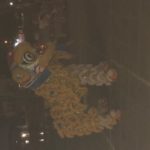 head, attaching the skirt, the final product.
head, attaching the skirt, the final product.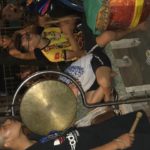 the drummer
the drummer
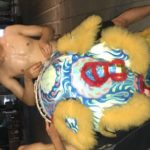 the head
the head 

